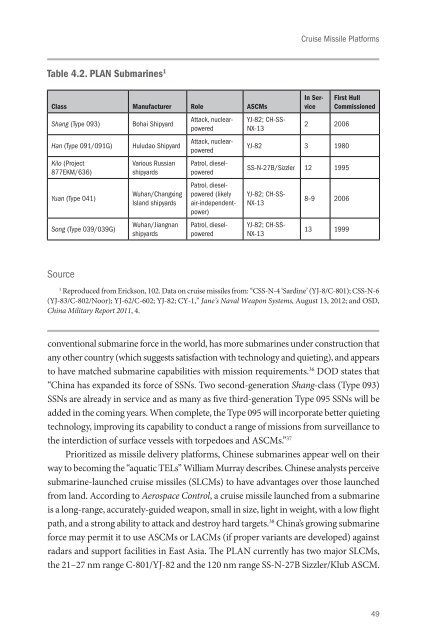Create successful ePaper yourself
Turn your PDF publications into a flip-book with our unique Google optimized e-Paper software.
Cruise Missile Platforms<br />
Table 4.2. PLAN Submarines 1<br />
Class Manufacturer Role ASCMs<br />
Shang (Type 093)<br />
Han (Type 091/091G)<br />
Kilo (Project<br />
877EKM/636)<br />
Yuan (Type 041)<br />
Song (Type 039/039G)<br />
Bohai Shipyard<br />
Huludao Shipyard<br />
Various Russian<br />
shipyards<br />
Wuhan/Changxing<br />
Island shipyards<br />
Wuhan/Jiangnan<br />
shipyards<br />
Attack, nuclearpowered<br />
Attack, nuclearpowered<br />
Patrol, dieselpowered<br />
Patrol, dieselpowered<br />
(likely<br />
air-independentpower)<br />
Patrol, dieselpowered<br />
YJ-82; CH-SS-<br />
NX-13<br />
In Service<br />
2 2006<br />
YJ-82 3 1980<br />
SS-N-27B/Sizzler 12 1995<br />
YJ-82; CH-SS-<br />
NX-13<br />
YJ-82; CH-SS-<br />
NX-13<br />
8–9 2006<br />
13 1999<br />
First Hull<br />
Commissioned<br />
Source<br />
1<br />
Reproduced from Erickson, 102. Data on cruise missiles from: “CSS-N-4 ‘Sardine’ (YJ-8/C-801); CSS-N-6<br />
(YJ-83/C-802/Noor); YJ-62/C-602; YJ-82; CY-1,” Jane’s Naval Weapon Systems, August 13, 2012; and OSD,<br />
China Military Report 2011, 4.<br />
conventional submarine <strong>force</strong> in the world, has more submarines under construction that<br />
any other country (which suggests satisfaction with technology and quieting), and appears<br />
to have matched submarine capabilities with mission requirements. 36 DOD states that<br />
“China has expanded its <strong>force</strong> of SSNs. Two second-generation Shang-class (Type 093)<br />
SSNs are already in service and as many as five third-generation Type 095 SSNs will be<br />
added in the coming years. When complete, the Type 095 will incorporate better quieting<br />
technology, improving its capability to conduct a range of missions from surveillance to<br />
the interdiction of surface vessels with torpedoes and ASCMs.” 37<br />
Prioritized as missile delivery platforms, Chinese submarines appear well on their<br />
way to becoming the “aquatic TELs” William Murray describes. Chinese analysts perceive<br />
submarine-launched cruise missiles (SLCMs) to have advantages over those launched<br />
from land. According to Aerospace Control, a cruise missile launched from a submarine<br />
is a long-range, accurately-guided weapon, small in size, light in weight, with a low flight<br />
path, and a strong ability to attack and destroy hard targets. 38 China’s growing submarine<br />
<strong>force</strong> may permit it to use ASCMs or LACMs (if proper variants are developed) against<br />
radars and support facilities in East Asia. The PLAN currently has two major SLCMs,<br />
the 21–27 nm range C-801/YJ-82 and the 120 nm range SS-N-27B Sizzler/Klub ASCM.<br />
49


